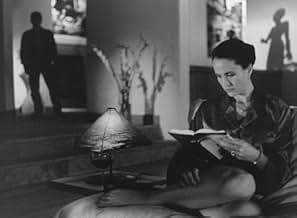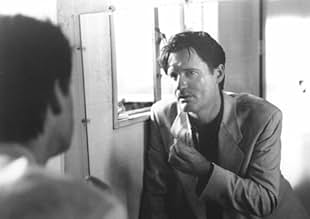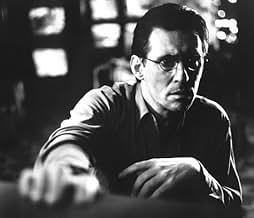IMDb-BEWERTUNG
5,6/10
5462
IHRE BEWERTUNG
Mike ist ein erfolgreicher Hollywood-Produzent von Gewaltfilmen. Dann erlebt er selbst extreme Gewalt, wird vermisst, schließt sich einigen Latino-Gärtnern an und lässt sein Leben Revue pass... Alles lesenMike ist ein erfolgreicher Hollywood-Produzent von Gewaltfilmen. Dann erlebt er selbst extreme Gewalt, wird vermisst, schließt sich einigen Latino-Gärtnern an und lässt sein Leben Revue passieren.Mike ist ein erfolgreicher Hollywood-Produzent von Gewaltfilmen. Dann erlebt er selbst extreme Gewalt, wird vermisst, schließt sich einigen Latino-Gärtnern an und lässt sein Leben Revue passieren.
- Auszeichnungen
- 1 Gewinn & 4 Nominierungen insgesamt
Nicole Ari Parker
- Ade Kenya
- (as Nicole Parker)
Samuel Fuller
- Louis Bering
- (as Sam Fuller)
Empfohlene Bewertungen
How 'bout a four? Visually, there are some great moments. I think the most interesting scenes are those where there is no dialogue but the camera follows the characters as they inwardly contemplate what this all means (Bill Pullman, Andie McDowell). Unfortunately, we as the viewers are also given (too much) time to contemplate what it means. Everything is WAY too understated. The movie slows to a stop in many places. You start to like it (the romance with Kat and the investigator, the interaction of Bill Pullman's character and the Mexican-American people) and then it doesn't follow through. The dialogue at the film school, in which the characters give a monologue for a class is probably the most interesting dialogue. Some rap, some tell a story, some recite their own poetry. That was the most moving part of the movie. While Wenders has a important point to make, it doesn't come through clearly and the viewer is left uncaring, uninterested. Maybe the only thing that could have helped the End of Violence is more good ole fashioned...violence <g>.
Wim Wender's The End of Violence is a rather disjointed and uninvolving piece of film-making. It wants to be a tale about how violence affects our lives and how, once exposed to it, we find ourselves fundamentally changed. It might actually succeed if it wasn't busy confusing the audience and boring them to death at the same time.
As the film opens, we are treated to a day in the life of Hollywood producer Mike Max (Bill Pullman), who is busy wheeling and dealing through multiple phones and computer connections, all the while ignoring his wife, Paige (Andie McDowell). While he is out during the day, he is kidnapped by two not quite bright hit men who are killed in a mysterious fashion and Mike Max manages to escape. He is found dazed by some Latino gardeners and Mike decides that he needs to hide from his old life to protect himself while discovering that violence, which he has peddled in action movies, is a bad thing. Meanwhile, Paige has taken over her husbands company in his absence and developed a relationship with a recording artist named Six (K. Todd Freeman) who provides the love she was lacking in her relationship with Mike. Also meanwhile, technical whiz Ray Bering (Gabriel Byrne) is busy putting the finishing touches on a high-tech surveillance system that the government hopes to use to bring violence in the city under control. However, Ray begins to suspect that the system is possibly being used for nefarious purposes and is trying to get someone to listen to him. And yet elsewhere still, stuntwoman turned actress Cat (Traci Lind) is getting her big acting break in Mike's latest film, and she finds herself somewhat smitten with detective Dean Brock (Loren Dean) who is investigating the disappearance of Mike.
As you can probably tell from the above paragraph, The End of Violence has a lot going on. The problem is that little of it is compelling and because the film is busy juggling so many plot threads at the same time, several of them seem like afterthoughts. The subplot featuring Paige's involvement with Six, for instance, has absolutely no emotional resonance for the audience because we barely know these people. The film also takes a lot of side trips to inexplicable scenes where people gather at performance art sessions to get some bigger message across, I guess, but they just end up being pointless and drawing the film out even more.
Wenders manages to suck the life out of most of the scenes in the film. The acting is uniformly wooden and unconvincing, the characters are little more than bodies going through the motions, and the plot is half-explained and developed. Take the plot thread of Ray trying to discover the truth about the surveillance system. It is revealed eventually that he has actually already been in contact with Mike about it with the hopes of revealing the system to the public, but the film has so many pieces moving around that it takes forever to make the connection between those two characters.
The film also features dreaded voice-over monologues that are just silly and pretentious. The anti-violence message, what there is of it, is also heavy-handed, to say the least. In one scene, Six speaks to Mike on the phone and gives us a long explanation about why violence is good and people revel in it. You can practically see Wenders on his soapbox while this scene is going on.
I suppose this movie is supposed to be a thriller to some degree, but there is little that is thrilling about The End of Violence. It is a monotonous bore of a film that comes to a rather abrupt ending without really dealing with all of the issues it seems to want to explore. Instead of an end of violence, I'll take an end to this particular mess.
As the film opens, we are treated to a day in the life of Hollywood producer Mike Max (Bill Pullman), who is busy wheeling and dealing through multiple phones and computer connections, all the while ignoring his wife, Paige (Andie McDowell). While he is out during the day, he is kidnapped by two not quite bright hit men who are killed in a mysterious fashion and Mike Max manages to escape. He is found dazed by some Latino gardeners and Mike decides that he needs to hide from his old life to protect himself while discovering that violence, which he has peddled in action movies, is a bad thing. Meanwhile, Paige has taken over her husbands company in his absence and developed a relationship with a recording artist named Six (K. Todd Freeman) who provides the love she was lacking in her relationship with Mike. Also meanwhile, technical whiz Ray Bering (Gabriel Byrne) is busy putting the finishing touches on a high-tech surveillance system that the government hopes to use to bring violence in the city under control. However, Ray begins to suspect that the system is possibly being used for nefarious purposes and is trying to get someone to listen to him. And yet elsewhere still, stuntwoman turned actress Cat (Traci Lind) is getting her big acting break in Mike's latest film, and she finds herself somewhat smitten with detective Dean Brock (Loren Dean) who is investigating the disappearance of Mike.
As you can probably tell from the above paragraph, The End of Violence has a lot going on. The problem is that little of it is compelling and because the film is busy juggling so many plot threads at the same time, several of them seem like afterthoughts. The subplot featuring Paige's involvement with Six, for instance, has absolutely no emotional resonance for the audience because we barely know these people. The film also takes a lot of side trips to inexplicable scenes where people gather at performance art sessions to get some bigger message across, I guess, but they just end up being pointless and drawing the film out even more.
Wenders manages to suck the life out of most of the scenes in the film. The acting is uniformly wooden and unconvincing, the characters are little more than bodies going through the motions, and the plot is half-explained and developed. Take the plot thread of Ray trying to discover the truth about the surveillance system. It is revealed eventually that he has actually already been in contact with Mike about it with the hopes of revealing the system to the public, but the film has so many pieces moving around that it takes forever to make the connection between those two characters.
The film also features dreaded voice-over monologues that are just silly and pretentious. The anti-violence message, what there is of it, is also heavy-handed, to say the least. In one scene, Six speaks to Mike on the phone and gives us a long explanation about why violence is good and people revel in it. You can practically see Wenders on his soapbox while this scene is going on.
I suppose this movie is supposed to be a thriller to some degree, but there is little that is thrilling about The End of Violence. It is a monotonous bore of a film that comes to a rather abrupt ending without really dealing with all of the issues it seems to want to explore. Instead of an end of violence, I'll take an end to this particular mess.
This is an astounding movie, and as others have noted, it is precisely the kind of movie that passes most people by because it rocks so gently as to be almost imperceptible.
The first time I saw this, I was disappointed. 'Until the End of the World', to me, is a brilliant piece of work, with more beauty, reverie, and complexity than any ten average films put together.
So...I was ready for some heady stuff with 'End'. But the movie seemed to be lost, missing in action.
But six months later I watched it on video, and I realized I was looking at an entirely different movie.
Then I watched it again...and again, and again, until I'd seen the thing ten times, including one where I only listened to the film, to see if I was simply addicted to Wim's luminous visuals.
What you realize is that this film is cooking up some very threatening ideas about the quality and nature of love, and the companion six degrees of violence and hatred. It is really about the way in which fear and love pulse in contrary and similar ways, much like particle and wave, dancing together.
It's also a fantastic critique the "confederacy of dunces" and the manner in which we manufacture enemies to suit our paranoia.
I must say that there are few directors that move me as much as Wim Wenders, and I have to confess that I have cried many times over the beauty and grace of some of the scenes and visuals in this movie. Much like Robert Altman or Atom Egoyan, Wenders cares about people, believes in their struggles, and he creates tension that moves them, at least temporarily, to understand their natures more fully.
A masterpiece, if a masterpiece means your heart moves even slightly...
PS Ry Cooder's soundtrack is brilliant!
The first time I saw this, I was disappointed. 'Until the End of the World', to me, is a brilliant piece of work, with more beauty, reverie, and complexity than any ten average films put together.
So...I was ready for some heady stuff with 'End'. But the movie seemed to be lost, missing in action.
But six months later I watched it on video, and I realized I was looking at an entirely different movie.
Then I watched it again...and again, and again, until I'd seen the thing ten times, including one where I only listened to the film, to see if I was simply addicted to Wim's luminous visuals.
What you realize is that this film is cooking up some very threatening ideas about the quality and nature of love, and the companion six degrees of violence and hatred. It is really about the way in which fear and love pulse in contrary and similar ways, much like particle and wave, dancing together.
It's also a fantastic critique the "confederacy of dunces" and the manner in which we manufacture enemies to suit our paranoia.
I must say that there are few directors that move me as much as Wim Wenders, and I have to confess that I have cried many times over the beauty and grace of some of the scenes and visuals in this movie. Much like Robert Altman or Atom Egoyan, Wenders cares about people, believes in their struggles, and he creates tension that moves them, at least temporarily, to understand their natures more fully.
A masterpiece, if a masterpiece means your heart moves even slightly...
PS Ry Cooder's soundtrack is brilliant!
I'm not surprised that a child would not understand this movie. To me it was very meaningful, but only in terms of lived experience in jobs and politics. It's really "Brave New World," where authority figures keep order by putting up cameras everywhere and intervening to eliminate anyone who is disorderly or criminal. Violence is a huge preoccupation, but only tolerated as make-believe -- but the make-believe gets confused with real violence. Control, transgression, power are the pivots of the well-to-do. Ashcroft stuff.
But the Mexican and immigrant families offer a warmer, truer alternative. In the end, they are more powerful because they are free and can think. The Kinko's episode, in which the police are defeated from taking control by their own preconceptions, is a good example. As underlings, laborers, the Mexicans understand what's at stake and they are everywhere, invisible to their employers.
The intellectual technician doesn't catch on until it's too late.
I'm told that what I saw was a re-cut and that the early version was indeed chaotic with a lot of loose ends. All I can say is that now this is one of the videos I rewatch and ponder.
But the Mexican and immigrant families offer a warmer, truer alternative. In the end, they are more powerful because they are free and can think. The Kinko's episode, in which the police are defeated from taking control by their own preconceptions, is a good example. As underlings, laborers, the Mexicans understand what's at stake and they are everywhere, invisible to their employers.
The intellectual technician doesn't catch on until it's too late.
I'm told that what I saw was a re-cut and that the early version was indeed chaotic with a lot of loose ends. All I can say is that now this is one of the videos I rewatch and ponder.
You don't turn to Wim Wenders when you're looking for nerve-tightening suspense. Though written (by Nicholas Klein, with Wenders) in paranoid-thriller form, the script lacks even a nubbin of McGuffin to anchor the narrative. Two stories run in parallel: Bill Pullman's an action-film producer gone missing after an attempt on his life; Gabriel Byrne's a NASA computer jock on loan to a mysterious satellite surveillance project. Just as yuppie cop Loren Dean is on the point of tying the two tales together, the movie's over, the plot unresolved.
Oh, well: Los Angeles (mainly Malibu, Santa Monica, and Griffith Park) looks great (cinematography Peter Przgoda), and Wenders has an uncanny ability to get actors to feel comfortable in their skins. The most notable skin in question is Traci Lind's: her role as a stunt-woman turned aspiring actress would have made her a star in a more mainstream movie.
If you're a Wenders fan, don't let the commercial failure of this film put you off: Compared to, say, 'Far Away, So Close' it's as electrifying as 'The 39 Steps.' And somehow, as usual, Wenders's almost childlike intensity of gaze makes you look harder, too. The aroma of the film lingers, even as its substance slides through your fingers like sand.
Oh, well: Los Angeles (mainly Malibu, Santa Monica, and Griffith Park) looks great (cinematography Peter Przgoda), and Wenders has an uncanny ability to get actors to feel comfortable in their skins. The most notable skin in question is Traci Lind's: her role as a stunt-woman turned aspiring actress would have made her a star in a more mainstream movie.
If you're a Wenders fan, don't let the commercial failure of this film put you off: Compared to, say, 'Far Away, So Close' it's as electrifying as 'The 39 Steps.' And somehow, as usual, Wenders's almost childlike intensity of gaze makes you look harder, too. The aroma of the film lingers, even as its substance slides through your fingers like sand.
Wusstest du schon
- WissenswertesThere is a scene in the film where we see a live recreation of the painting "Nighthawks" by Edward Hopper.
- PatzerWhen Page is holding Mike at gunpoint she holds the gun upward with the bottom of the handle facing outward and the ammo clip is clearly missing. Yet when Mike exits through the patio door she fires the gun and shatters the glass.
Obviously there was a bullet in the chamber.
- SoundtracksBailare (El Merecumbe)
Written, Performed and Produced by Raul Malo
Courtesy of MCA Records, by arrangement with Universal Music
Special Markets
Top-Auswahl
Melde dich zum Bewerten an und greife auf die Watchlist für personalisierte Empfehlungen zu.
- How long is The End of Violence?Powered by Alexa
Details
- Erscheinungsdatum
- Herkunftsländer
- Sprachen
- Auch bekannt als
- The End of Violence
- Drehorte
- Griffith Observatory, 2800 E Observatory Rd, Los Angeles, Kalifornien, USA(Multiple interior and exterior scenes; as Ray Bering's workshop. Hillside hike viewpoint just south of observarory)
- Produktionsfirmen
- Weitere beteiligte Unternehmen bei IMDbPro anzeigen
Box Office
- Budget
- 5.000.000 $ (geschätzt)
- Bruttoertrag in den USA und Kanada
- 386.673 $
- Weltweiter Bruttoertrag
- 386.673 $
- Laufzeit
- 2 Std. 2 Min.(122 min)
- Farbe
- Sound-Mix
- Seitenverhältnis
- 2.35 : 1
Zu dieser Seite beitragen
Bearbeitung vorschlagen oder fehlenden Inhalt hinzufügen





































